
Training a cat to “Sit” is loads of fun, has many practical benefits and is the base for several cues like Shake Hands, High-Five, Stay and Sit on a Stool.
Teaching a cat to “sit” on signal is likewise the foundation for petting, handling, husbandry care practices and a vital cue that might be applied to prevent undesirable behaviours like jumping on counters, running outside the front entrance and chasing a brand-new pet or toddler.
Follow this easy step-by-step guide to learn how to train your cat to Sit!
Training Guidelines
1. Ultimate Environment

The ideal environment should comprise of a quiet room where your kitty doesn’t get easily distracted, far away from toys, food bowl, other household pets and barking dogs.
2. Props

Prepare all the necessary items like a clicker, target stick, treat bag, treats, toys, and props before the cat training session.
3. Rewards
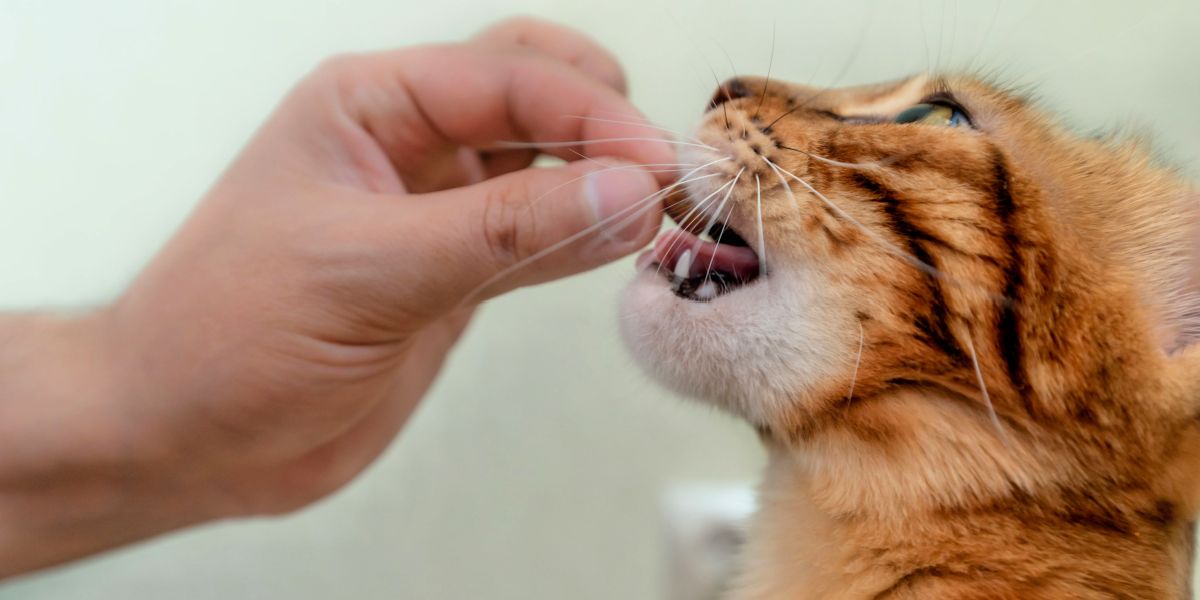
Use high-value reinforcement; whatever your cat is motivated or interested in at that moment.
Best food treats include soft miniature-sized delicacies like air/freeze-dried lamb, tuna, BBQ chicken, creamy Dine / Churu lickable velvety treat or canned wet food. Certain cats won’t take food straight from your fingers, try using a spoon or popsicle stick or just place treats on a little flat plate in front of your moggie.
For cats who are play driven, prepare a minimum of two toys to rotate throughout the training session; feather wand dangler and teasers work best since they move quickly yet mimic natural prey. Allocate specific training trinkets and keep them out of reach to keep the novelty.
Other reward types include petting, chin-rubs or brushing, all contingent on your individual cat.
4. Clicker Type
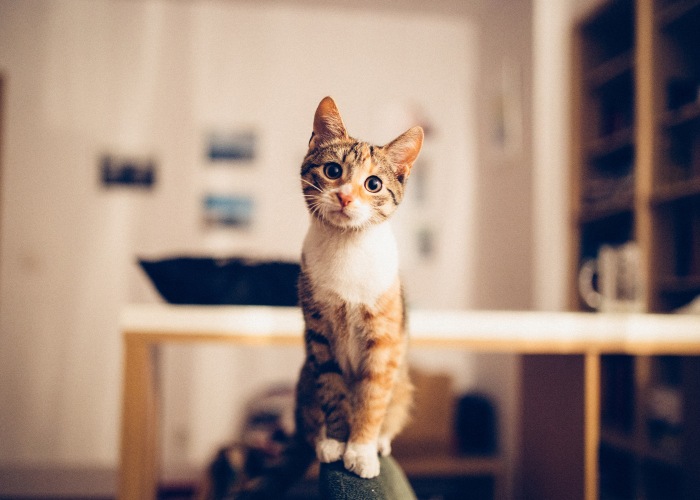
Obtain the correct clicker type; most cats will like the clicker sound; however, some may fear it. If your cat is frightened of the remote, place it in your pocket, use a softer sound clicker, a ballpoint pen or roll your tongue instead.
5. Session Timeline And Duration – Keep It Short!
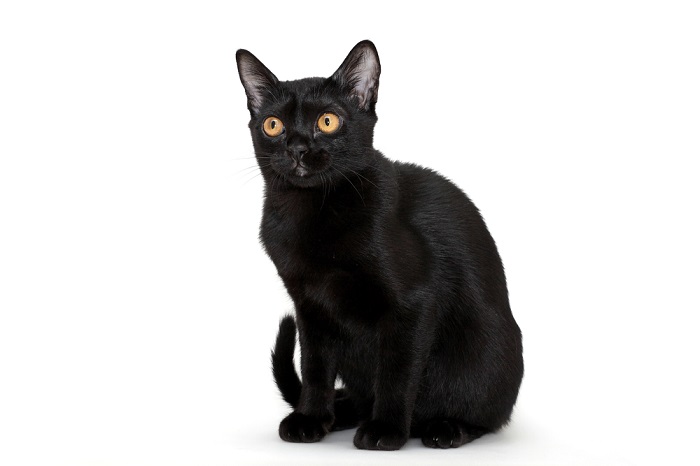
Most effective training sessions are short since cats have a brief attention span. Initial teaching should involve few clicks and treats, less than a minute. Commonly feline training sessions should be short but lots of fun between 2 to 5 minutes (ideally 3mins), then have a break and play together with your cat.
Ideally train before or in between mealtimes (when your cat is hungry), be cautious to not overfeed more than your cat’s measured daily feeding allowance.
Remember, if either you or your cat not feeling well today, the cat isn’t in the mood, wait till tomorrow, training should be enjoyable for both.
How To Train A Cat To Sit Step-By-Step?

Choose a verbal cue: “Sit”, “Sit Pretty”.
Simplest Technique: Luring
Step 1: Break a small treat or prep a Churu tube, let your cat smell it to get its interest and place it in your hand.
Step 2: Stand or crouch in front of your cat (don’t lean over your cat, some may feel intimidated).
Step 3: Move your hand gradually up above the nose and head, between the ears, towards the tail while the treat is out of reach.
Step 4: As the cat follows your hand, the remainder of the body will shift to the sit position. Click and treat immediately as the bum hits the ground.
Step 5: Repeat step 4 few times.
Step 6: Use the hand motion in step-3 without a treat. Click when the butt strikes the floor, provide a treat from the opposite hand. Repeat this step few times.
Step 7: Once your cat knows to sit down together with your raised hand add the verbal cue “sit” immediately before your cat starts to take a seat.
Step 8: Toss the treat away to reset him/her and practice again.
Step 9: When your cat masters the sit cue, increase the distance from your cat and encourage him/her to sit longer.
Step 10: Once your cat sits proficiently, progressively phase clicking and reward intermittently.
Alternative Technique: Prompting With Target Stick
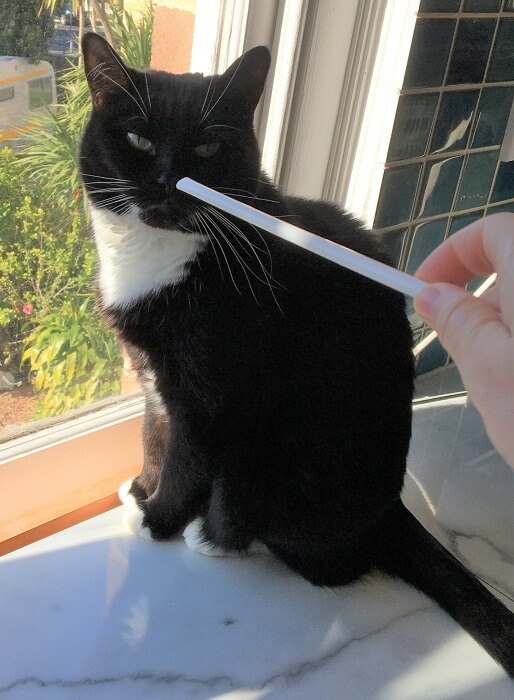
An alternative way to conduct cat training is to use target sticks where and move them gently up and round the cat’s nose. Melina Grin / Cats.com
Step 1: Sit, stand or crouch in front of your cat.
Step 2: Move the target stick gently up and round the nose.
Step 3: As your cat follows the target with its eyes and nose, the remainder of the body will shift to the sit position. Click and treat immediately as the bum hits the ground.
Step 4: Repeat step 3 several times.
Step 5: When your cat has grasped the cue, replace the target along with your finger.
Step 6: Once your cat knows to sit down with your finger raised above the cat’s head, add the verbal cue “sit” immediately before he/she starts sitting.
Step 7: Toss the treat away to reset him/her and try again.
Step 8: Repeat step 6 several times.
Step 9: Encourage your cat to sit down for extended periods, don’t force it.
Step 10: Increasingly phase clicking and only reward sporadically.
Training Tips, Tricks And Troubleshooting
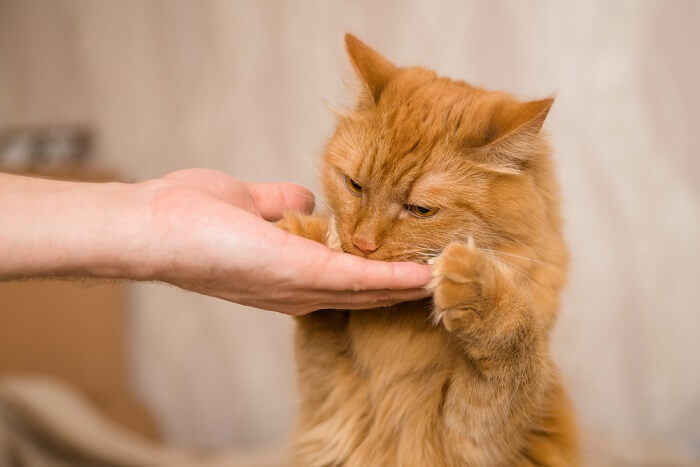
Be patient with your cat, only use positive reinforcement and don’t punish or coerce your them into a sit position since it may cause frustration, anxiety together with stress resulting in training aversion.
If your cat struggles to do an entire sit, click and reward small steps (shaping); like a nose sniff, head tilt, kneeling of hind legs, etc.
If your cat stands up on their back legs, rather than sitting, bring your hand closer to the nose.
For felines that tend to maneuver backward as a substitute to squatting, train them in front of a wall.
Always set your cat for success by watching his or her body language for signs of tiredness or agitation like not consuming treats, easily getting distracted and not performing relevant cue. Finish on a cheerful note and try again another day.
Be patient, only use positive reinforcement and don’t punish or coerce your cat into a sit position since it may cause frustration, anxiety together with stress resulting in training aversion.
Conclusion

Training your feline to “sit” will provide you with the groundwork for clicker training moreover offer your kitty something interesting to try and do while reducing frustration and boredom.
Clicker coaching will strengthen your human-cat bond and enrich your cat’s life in more ways than you have imagined possible!
Consider sharing successful training videos with our Facebook Cat Community.
Frequently Asked Questions
How do I train my cat to sit?
Clicker and target training are the most effective methods to teach your cat to sit.
Alternatively, lure your cat by holding a treat or a spoon with food smeared up above their nose and when the cat’s bum strikes the ground offer a reward. You can also click and treat your cat when he/she sits naturally, just add the word “sit” once the behaviour is predictable.
Remember to phase out clicking and treats once they learnt the prompt.
How hard is it to teach a cat to sit?
It’s easy to teach a cat to sit with patience, consistency and high value treats or toys.
The best time to start out training is when your cat is keen to interact with you and when their hungry or playful.
What is the easiest trick to teach a cat?
“Sit” cue is the easiest trick to teach a kitten as well as an adult cat since sitting is a natural behaviour a cat performs on daily basis; while eating, watching birds, playing and object batting.
By starting sit training during kittenhood, you will teach that only calm and polite behaviour is rewarded rather than clawing or meowing.



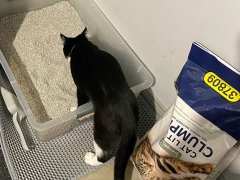




Thanks…I am just another crazy cat 🐈 😻 🐈⬛️ mom to my 3 fur babies!